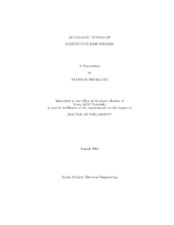| dc.description.abstract | Integrated high-Q continuous-time filters require adaptive tuning circuits that will correct the filter parameters such as center frequency and quality factor (Q). Three different automatic tuning techniques are introduced. In all of the proposed methods, frequencyand quality factor tuning loops are controlled digitally, providing stable tuning by activating only one loop at a given time. In addition, a direct relationship between passband gain and quality factor is not required, so the techniques can be applied to active LC filters as well as Gm-C filters. The digital-tuning method based on phase comparison was verified with 1% tuning accuracy at 5.5 MHz for Q of 20. It uses phase information for both Q and center-frequency tuning. The filter output phase is tuned to the known references, which are generated by a frequency synthesizer. The core tuning circuit consists of D flip-flops (DFF) and simple logic gates. DFFs are utilized to perform binary phase comparisons. The second method, high-order digital tuning based on phase comparison, is an extension of the previous technique to high-order analog filters without depending on the master-slave approach. Direct tuning of the overall filter response is achieved without separating individual biquad sections, eliminating switches and their parasitics. The tuning system was verified with a prototype 6th order bandpass filter at 19 MHz with 0.6 MHz bandwidth, which was fabricated in a conventional 0.5 [mu]m CMOS technology. Analysis of different practical limitations is also provided. Finally, the digital-tuning method based on magnitude comparison is proposed for second-order filters for higher frequency operations. It incorporates a frequency synthesizer to generate reference signals, an envelope detector and a switched comparator to compare output magnitudes at three reference frequencies. The theoretical analysis of the technique and the simulation results are provided. | en |


